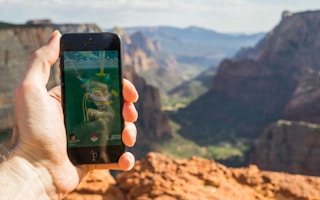Anyone who has been outdoors in a populated area in the past month will be aware of the massive success of Pokémon GO, which has rocketed to the top of the gaming charts.
People have been avidly collecting Pokémon creatures in various media formats for two decades, so it was a logical move to use smartphone technology to turn the franchise into a “mobile augmented reality” (MAR) gaming app.
It has proved to be an economic as well as a social phenomenon, sending the market value of its owner Nintendo soaring to US$39.9 billion. But the game was not actually developed by Nintendo; it was created by Google spin-off Niantic, which also built Pokémon GO’s popular MAR predecessor, Ingress.
Similar to Pokémon GO, Ingress is a reality-embedded sci-fi game in which players interact with real-world objects that are overlaid (using smartphone cameras) by a veneer of simulated characteristics.
In a new paper published in the journal Restoration Ecology, we argue that MAR games such as these can be a force for good in ecology and conservation, rather than being a cause for concern, as others have argued.
The key is not to lament or rail against the popularity of gaming or augmented reality, but rather to embrace what makes them a success. They tap into people’s sense of fun and competitiveness, and they get people into the great outdoors – and this is all stuff that can encourage people to embrace nature.
The problem
The growth of our modern civilisation, spurred on by technological innovations, has been underpinned by the exploitation of the natural environment. Today, a large fraction of the Earth, once swathed in wilderness, is now monopolised by humans. Populations of plants and animals have declined, leading to local losses and global extinctions, as a result of habitat destruction, harvesting, invasive species, and pollution.
Yet although the direct causes of wildlife loss are clear enough, what’s less obvious is why many people seemingly don’t care. The environmental writer George Monbiot has ascribed society’s ongoing destruction of the environment to the fact that not enough people value nature and wilderness any more.
This “eco-detachment” has been described as a symptom of our modernised, urbanised world, in which new technology both dominates peoples’ interests and simultaneously increases society’s ability to damage the environment.
But what if augmented reality – from MAR apps on smartphones to HoloLenses – could be harnessed in a positive and proactive way, to reconnect the wider public to nature and so unlock their inherent biophilia?
“
A recent editorial in Nature highlighted some of the potential uses of Pokémon GO, Ingress and others, suggesting that MAR games might even be used to discover and describe new species.
What if a smartphone game was created that focused not on features of the cityscape, but rather on “gamifying” nature, wildlife, and human interactions with the natural environment?
Such a game would lead its players to actively choose to experience nature. They would connect to it, and protect it (as an in-game reward), and thus understand its value.

Ingress enthusiasts. Hey, at least they’re outdoors, right? Image: R4ph4ell-pl/Wikimedia Commons, CC BY-SA
Getting more of society to connect with nature has long been an elusive dream of environmentalists. More than a decade ago, a group of leading conservation biologists famously found children were far more expert at recognising Pokémon characters than they were at identifying common wildlife groups. The problem isn’t with spotting “species” per se – it’s that they were mainly exposed to the electronic ones and not the real ones.
This issue of where people invest their attention is crucial. Ingress now has more than 7 million active players, and has been downloaded by 12 million people since its release in 2012. The fact that the game requires you to get out and about means it encourages players to locate, recognise, and identify with an array of cultural icons they might otherwise ignore.
Egress!
So here’s the challenge: to create a new version of Ingress (let’s call it “Egress”), that is educational and positive, as well as popular. It might also use augmented reality to visualise environmental changes, either good (restoration) or bad (damage), in people’s local landscapes. To be a hit, it would need to both capture an audience and to foster a community. And it could even generate data for citizen science projects.
There are lots of possibilities for how an app such as this could work. Perhaps it might involve using smartphones to photograph, locate, and automatically “tag” species within a landscape; or to identify rare plants or insects; or detect signs of animal activity (diggings, droppings, and so on). The crucial point is that although its focus would be on ecology and nature, it needs to also incorporate a fun gaming element – sort of like a high-tech version of those old birdwatching handbooks, but one that offers more kudos for spotting rarer species.
A recent editorial in Nature highlighted some of the potential uses of Pokémon GO, Ingress and others, suggesting that MAR games might even be used to discover and describe new species.
Who doesn’t want a new animal or plant to be named after them? Such citizen science activities would strengthen links between research, conservation, and the community.
What Ingress and Pokémon GO have shown is that it is possible to get millions of tech-savvy people out of their living rooms and basements and actively engaging with the wider world. While it’s impossible to guarantee that any project will go viral, this recent experience with MAR shows that people really can be persuaded, in large numbers, to get outside and explore.
That’s surely the first and most necessary step towards getting people to reconnect with, and care about, nature in the digital age.
![]()
Jessie C. Buettel is a postgraduate (P.h.D) student at University of Tasmania and Barry W. Brook is ARC Australian Laureate Professor, University of Tasmania. This article was originally published on The Conversation.











